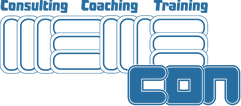Outline the system
When we examine circumstances, we see the whole without recognizing what is happening or changing. To make the overwhelming complexity processable, we need brain-friendly visualization methods that reveal patterns.
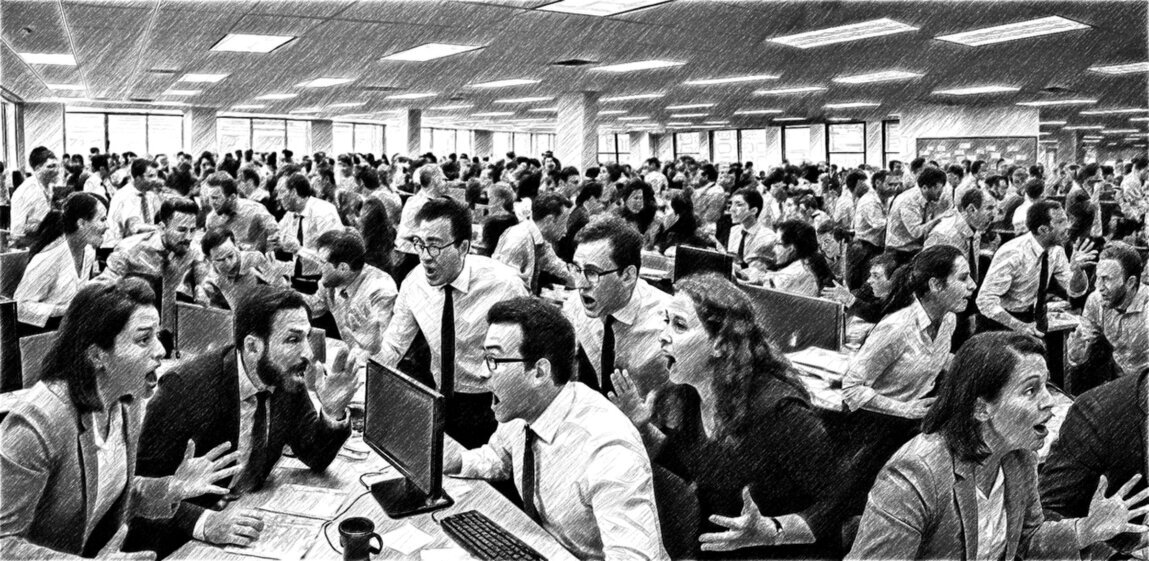
With the seven-plus-minus-two chunks that we can handle in our consciousness at any one time, linear relationships are best thought of as when this happens, then that happens. To examine vucaneous systems, we need thinking tools - pens, paper, computers, and models to visualize the big picture.
A map is the archetype of a model. The reality of a landscape is depicted on a 2D medium. The scale determines the level of detail - at 1:100,000, one centimeter on the map corresponds to one kilometer in reality. Since a model will never reach the level of detail of reality, modelers must decide which facts to depict at what level of detail - what this is all about and for what purpose. This mapping of the overall picture provides the basic elements for the work.
The purpose of a model is to make one A W A R E of what exists and what will happen in the future.
- Noticing
Perceiving the circumstances, associated elements, relationships, and boundaries.
- Categorize
Classify what you have noticed in your own mental models, beliefs, values, conditions, and expectations.
- Valuing
The categorization sometimes fits better and sometimes less. Evaluation determines the fit of what is perceived in the existing mindset and identifies both desired and undesired consequences.
- Rewriting
The findings are drafted, initial concepts created, and formulated for specific purposes.
- Reflecting
The ideas described are rethought and discussed to be improved.
- Strategizing
A strategy is developed to introduce the new
- Transfer
The results are applied in practice and, over time, become the new standard.
Let's look at a situational change that leads to resistance in the workforce. For this purpose, the system is outlined with its essential components: the 3D-Action-Frame is mapped, elements are described, the organization is outlined, the system network is created, effective impulses are identified, and preliminary assumptions are formulated.
Mapping the 3D-Action-Frame
Everything that happens can be located within the 3D-Action-Frame - spatially, temporally, and topically.
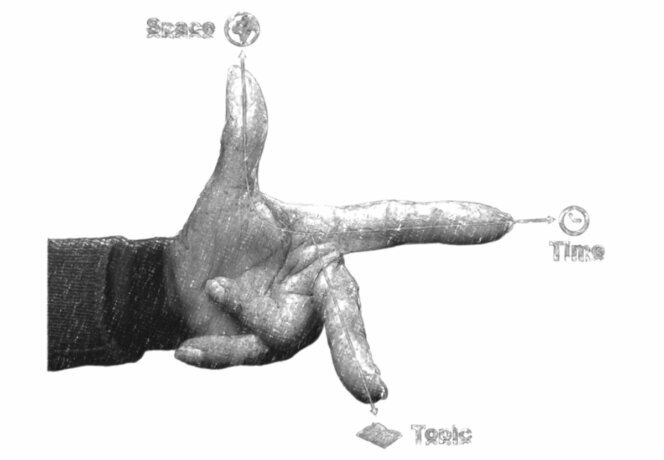
Space
Space determines the boundaries of the observed world. It describes the boundaries of the observed world, which can be defined geographically, role-specifically, perspectively, and abstractly. Geographically, we localize an event on a continent, in countries, regions, cities, buildings, within rooms, or outside in squares, in public or private spaces.
The roles are defined by the position assumed: 1) from one's perspective; 2) from the perspective of a counterpart; 3) from the neutral perspective of an observer of the positions 1 and 2.
The perspective determines the observed section, with its level of detail - detailed from below, from a frog's-eye view, or roughly from above, from a bird's-eye view, on the same level from the left or the right, and so on.
The abstract spaces are mental models, such as the (in)finite and (non-)empty spaces of the worlds of thought, cultural spaces, or experiential worlds.
Example: The event took place in Port Lligat, Spain, in front of the door of Dali's white villa. From my memory, it was a profane beach with its fishing boats, and this place was charged with surrealism.
Time
Time is a general concept that we cannot explain beyond the fact that it passes and is measured with clocks and calendars. Heraclitus formulated it two and a half thousand years ago: Panta rhei (Everything flows). And until the invention of the clock, time passed while the sun operated the shadow clocks, and sand flowed through sand and water through water clocks. Today, we understand time as a sequence of events that makes time flow like the 24 frames of a movie. Although there is no final definition, we have found different ways of describing time: 1) as a temporal measure of points in time or durations; 2) with the perspectives of past, present, and future; 3) as an irreversible progression of time (timeline) with remarkable milestones. Example: It happened on July 14, 2012, at 11:30, after a visit to Figueres.
Topic
The topic is a technical category of subject areas, e.g., culture, organization, economy (e.g., specialist area, corporate function, task, influencing factors (PESTLE), resources), or technologies.Example: It is about Salvador Dali's places of activity on the Mediterranean.
The 3D-Action-Frame forms the stage for events, initiatives, and changes.
Describe elements (input-processing-output)
A system consists of linked elements that influence each other and whose states determine the circumstances. These system components fulfill distinct functions or tasks of real or abstract entities within the system.
- Real building blocks are objects such as products, components, machines, and buildings.
- Abstract elements are contents, ideas, imaginary figures, concepts, and symbols.
For each element, impact variables of the essential elements are selected, such as customer proximity, satisfaction at customer touchpoints, turnover, number of employees, employee and customer satisfaction, product or service quality, or number of complaints. The states change in parallel due to incoming data, a more or less complex processing, and generates outgoing data, which in turn flows into subsequent elements until the task is completed.
The elements are collected and described. In the next phase, the identified elements are observed and used to find leverage points for improvement.
Element/ System component | Input/ Status/ Output The elements are represented by variables that we use to track the system's behavior. They are influencing variables that simultaneously affect each other and alter the system's conditions. They supply an element with input data, which is processed and changes the state, and then act as input to other system components with their output. |
Draft organization
Organization is the planned structure, orderliness, and organization of structures that support integration, goal-oriented alignment, and the enhancement of the entire company’s effectiveness and efficiency. They are characterized by a shared value system and self-image, as well as common strategies, goals, and outcomes. They are described in terms of roles, hierarchies, processes, relationships, and networks
Recognize roles
Roles are the bedrock of an organization. They bundle tasks, authorities, and responsibilities to describe jobs, activities, and people. In contrast to personalized job descriptions, roles provide generalized profiles that are used in different functions to describe similar tasks. Thus, they are differentiated from one another, and duplication of work and blind work are avoided.
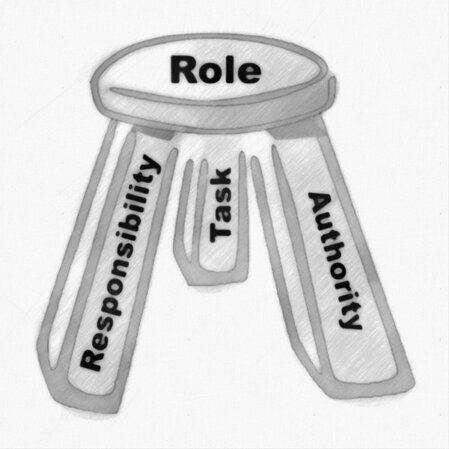
The relevant roles of the system should be described in a way that everyone understands what they do, the authorities they have, and what they are accountable for. It is crucial to recognize, outline, and, if necessary, expand the essential roles.
Role | Description |
Task | Tasks are activities. These can be execution or
management tasks that are used in core and support processes. Examples include
storing parts, sending invoices, and communicating with employees. |
Authority | Authority describes the rights of the role. On the
one hand, task performance involves taking actions - doing something, making
requests, or making decisions. On the other hand, managerial authority entails
the power to issue instructions, manage employees, establish guidelines, and
control the scope of responsibility. The format of the authorization can be
more or less formal. |
Responsibility | Responsibility refers to the duty to be accountable
for actions, results, and consequences arising from the task. Personal
responsibility is determined by one's actions or the actions of directly
assigned employees. Joint responsibility is a consequence of the position and
the associated power. It arises when decisions in other areas can be supported
or at least influenced. |
Outline structure and procedure
As soon as a group reaches a size of 100 to 250 members, it makes sense to divide it into two groups. They can be distributed functionally across several levels in an organizational structure or procedurally in a process-oriented organization across multiple business processes. The building blocks always consist of task, authority, and responsibility (TAR: the role)
The organizational structure distributes roles across levels. It creates hierarchies that consist of employees, teams, departments, divisions, and board managers. The structure determines the scope for top-down decisions and the reporting channels from top to bottom and vice versa.
The process organization describes the processes. A business process describes the sequence of tasks that occur from start to end.
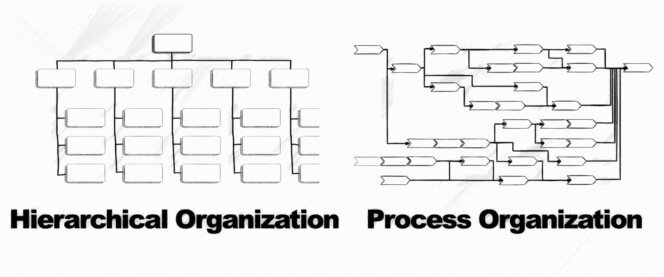
With the description of the organization, structures and service providers are established, integrated, and aligned in a goal-oriented manner to increase the effectiveness and efficiency of the organization. It describes commercial enterprises, nonprofit organizations, governmental and non-governmental organizations, as well as any other form of community (e.g., religious communities, syndicates). Extensive documentation is usually available, which provides many details and obstructs thinking in systems. Rough sketches of the participating roles and their relationship to each other are sufficient.
Sketch the organizational field
We place the interplay of roles as a starting point for discussion. Contrary to the system net, existing relationships emerge, along with their proximity to one another and the formation of spontaneous groups. It fosters a common understanding of the groups formed based on subject, topic, or other shared similarities.

The organizational mapping method presents a debatable constellation of a group. In the first step, roles are intuitively distributed in space and established in a collaborative and informative relationship with each other, i.e., until the scene suits everyone involved. In the second step, the team examines the resulting "picture" of seven aspects of Gestalt theory.
- What appears to be in the foreground "veils" the background - Law of Figure-Ground.
- What is close together seems to form a group - Law of Proximity.
- What continues coherently seems to belong together - Law of Continuity.
- What is fully enclosed seems to represent a unity - Law of Closure.
- What looks similar appears to have something in common - Law of Resemblance.
- What is recognizable based on experience - Law of Personal Experience.
- What is in one area seems to belong together - Law of Common Region.

System net
Courses of effect replace simple business processes and are depicted by a system net.
It consists of elements and relationships. The relationships describe two types of impact on the target element: the plus (+) or the minus (-). The Plus influences the following element in two directions: An increase in the source element strengthens, and a decrease weakens the target element. Similarly, the Minus influences in the opposite direction: An increase in the source element weakens, and a decrease strengthens the target element.
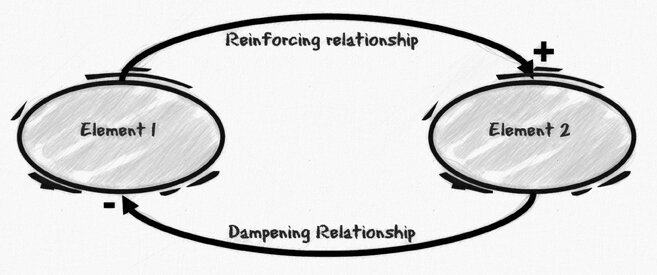
Throughout a time unit (Cycles can be an hour, a day, a week, a year, etc.), all elements change in mutual relation. As a result, the entire system is in a new state after one cycle, or in other words, in a new initial situation. The complex system behavior and points of leverage for impulses result from this dynamic baseline.
Elements
are variables that describe key factors, states, or decisions that change over time in response to inputs. Examples include turnover, the number of warranty cases, innovation backlog, risk readiness, customer focus, and product releases, among othersRelationships
connect the elements uni- or bi-directionally. A relationship has a positive, reinforcing effect on the target element with a plus sign or a negative, attenuating effect with a Minus Sign. The positive links should be interpreted as follows: Element 1 has a reinforcing impact on Element 2. It means that an increase in element 1 leads to an increase in element 2, and a decrease in element 1 leads to a reduction in element 2. The negative link causes element 2 to be lowered when element 1 is raised or element 2 to be raised when element 1 is reduced. Examples: the more claims, the lower the gains; the more written warnings, the less willingness to take risks. Relationships are found by asking questions about consequences and causes. Formulate assumptions
Assumptions arise from premises and conclusions that provide an unproven assertion or scientific hypothesis with additional meaning without critical examination, serving as the basis for a statement or action.
Premises
are conceptual elements derived from ideas that expand a statement by charging it with additional meaning and making it assessable, regardless of whether the claims are affirmed or denied. Examples include references, comparisons, conditions, or cause-and-effect relationshipsConclusions
are implications that recipients derive from the available context and world knowledge, along with their associations, such as facts, realism, clarity, or the amount of information.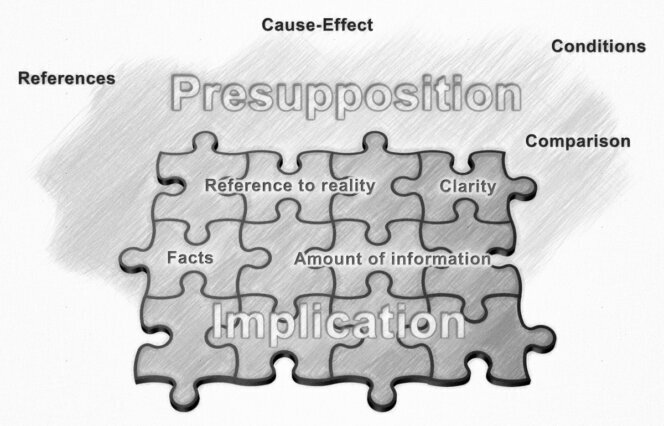
On the one hand, it's impossible to describe a situation fully, and on the other hand, recipients expand descriptions of circumstances with personal assumptions and conclusions. Ultimately, this creates different perspectives that must be taken into consideration.
To ensure that recipients share a desired meaning, possible assumptions should be anticipated. The following questions can be used to determine the assumptions: Which beliefs exist implicitly or can be derived from what is described? What mental models seem to exist? Which key concepts stand out?
Changes occur in all areas of a company. Since difficulties always arise, it makes sense to clarify the system to which those affected respond with resistance

